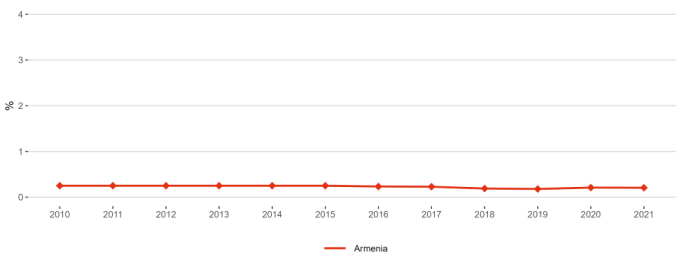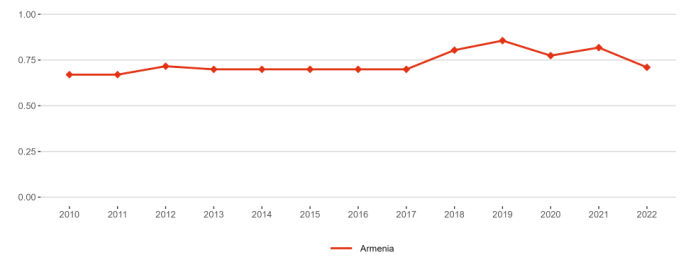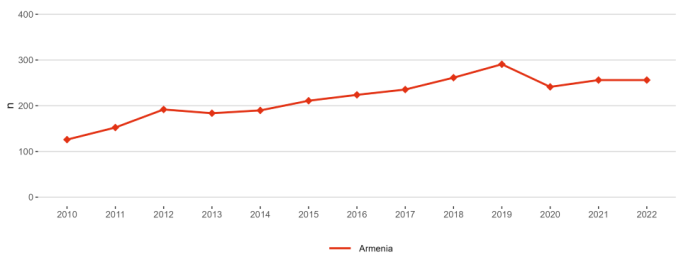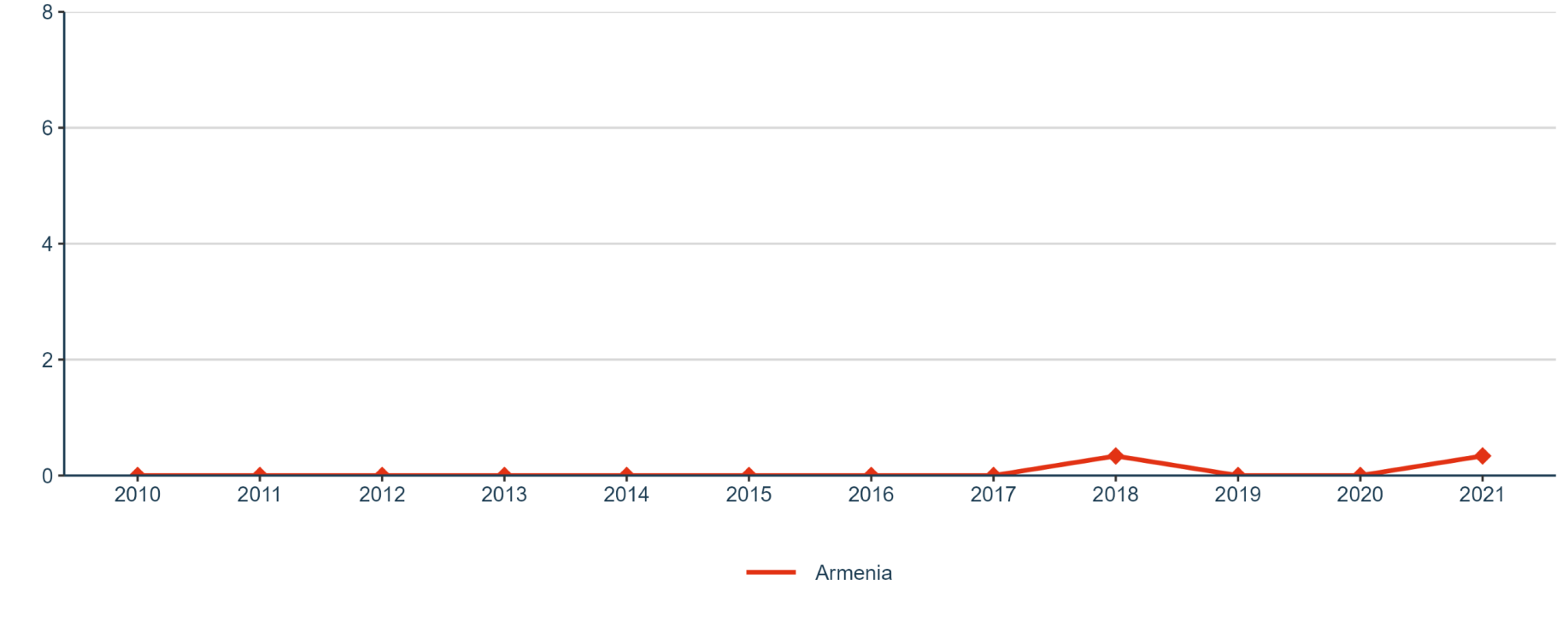ERA Country Report 2023
Armenia
Edited by Alasdair Reid (EFIS Centre)
as part of ‘Development of the ERA Scoreboard, the ERA Dashboard and the Regular Reports’ project for the European Commission, Directorate-General for Research and Innovation under Framework Contract N° 2018/RTD/A2/OP/PP-07001-2018 Lot 2 (EDAR)
Click here to download this country report![]()
- Table of contents
-
ERA Country Report 2023: Armenia
1. National context
1.1. Overview of the ERA policy agenda implementation
1.2. Policy context
2. Assessment of the Implementation of the ERA Policy Agenda and ERA Priorities
2.1. ERA Priority 1: Deepening a truly functional internal market for knowledge
2.2. ERA Priority 2: Taking up together the challenges posed by the twin green and digital transition and increasing society’s participation in the ERA
2.3. ERA Priority 3: Amplifying access to research and innovation excellence across the Union
3. Country-specific drivers and barriers
4. Final remarks
5. Bibliography
6. Annexes
6.1 Annex 1: Graphs
ERA Country Report 2023: Armenia
|
Key takeaways:
|
1. National context
1.1. Overview of the ERA policy agenda implementation
Armenia is currently in the 72nd position of the Global Innovation Index (GII) ranking among the best performing countries of the third quartile. In its engagement with R&I, the Armenian Government has committed to three ERA Policy Agenda actions ^, all falling under ERA Priority 1: Deepening a truly functional internal market for knowledge (see section 2). All the actions committed focus on the assessment of researcher performance, promoting attractive research careers and talent attraction and investment in research infrastructures.
Armenia does not yet have a national R&I strategy in place, but the Minister for Education, Science, Culture and Sport of the Republic of Armenia in December 2023 committed to place ERA priorities in the upcoming national research strategy
1.2. Policy context
Armenia’s R&I governance structure includes three main ministries and several related agencies ^. As far as scientific research is concerned, the Ministry of Education, Science, Culture and Sport (MoESCS) is the responsible ministry with the Higher Education and Science Committee (HESC),^ which, amongst other tasks, operates as the national research funding agency.
Created in 2019, the Ministry of High-Tech Industry (MoHTI) develops and implements policies in a number of areas including: high technology, information technology, information security, digitalisation, space and defence industry ^. The Ministry of Economy has responsibility for industrial policy, economic development and investment policies, including since 2019 agriculture. It also oversees intellectual property, standardisation, and quality policies ^.
In the field of R&I policy, all decisions are taken at the national level and while some attention is a paid to the regional interventions, R&I institutions and capacities are largely concentrated in the capital Yerevan (e.g. Armenia has 27 state universities, 23 in Yerevan and 4 outside the capital). The National Academy of Sciences (NAS) is the key research performing organisation, as well as advising on science policy and playing a role in the field of doctoral research. The NAS has 35 research institutes and scientific centres in five main disciplines: mathematical and technical sciences; physics and astrophysics; natural sciences; chemistry and earth sciences; and Armenology and social sciences. Aside from the NAS system, 47 institutes act under the remit of the State, and there are a number of not-for-profit/private research institutes.
Prior to 2020, two main policy documents framed the R&I policy: the Strategic Programme for the Development of Science Sector (SPDSS) 2017-2020 ^ and an Initial strategy of the formation of innovation economy (ISFIE). Various attempts have been made to develop a more long-term strategic R&I framework in Armenia, inter alia by EU-funded projects and national stakeholders. So far this has not resulted in the adoption of an R&I strategy, however, the HESC is reported to be drafting a research strategy with the aim for it to be approved soon. More broadly, UNECE points to the need to adopt a comprehensive innovation strategy aligned with national development goals that can guide innovation support across policy areas and stakeholders, leading to impactful policy interventions that drive innovation across all sectors of the economy ^ .
A new law on education and science has been under discussion and was initially planned for adoption in 2021, however, it is still to come into force. It will be developed in accordance with the GSF 2023 report, ^ aiming at strengthening the R&I capacity of the five Eastern Partnership (EaP) for the green and digital transition. Currently, the main policy development has been the adoption of the State Programme for Education Development (SPED) until 2030 by the Parliament in November 2022. This programme sets out an analysis of the current situation in terms of educational performance and structures, including STEM education and doctoral studies at universities. The programme’s strategic principles include universal inclusiveness, learning-focused educational environment and increase of education effectiveness. The main objectives are the internationalisation and export of educational services and products, thus improving Armenia’s position in the global education system. The higher education system will undergo significant reforms to improve international competitiveness. The SPED aims to include at least four universities in the top 500 universities of the world by 2030 ^. It foresees that the existing state universities will be consolidated into up to eight universities offering tuition-free education. All universities will be required to meet internationally acceptable licensing and certification requirements.
The programme notably proposes the merger/consolidation of universities and research centres of the NAS with the aim to “increase the quality and competitiveness of research”, including a generational change of the teaching and research staff and a revision of the management system of universities as part of their enlargement. During 2023, the project to enlarge universities and merge with research centres has been further formulated in the form of the ‘Academic City’ project, which is proposed to be developed at the site of the Institute for Physical Research of National Academy of Sciences in Ashtarak. The Government’s plan, adopted in October 2023, is to establish an “Academic City" that will group eight State universities with facilities to accommodate 50,000 staff. This project is, however, questioned by stakeholder groups such as Githuz which call for an overall increase in R&D funding to reach 1% of GDP and a reinforcement of the broader R&I ecosystem rather than investing in relocating universities.
2. Assessment of the Implementation of the ERA Policy Agenda and ERA Priorities
Armenia has committed to three ERA Policy Agenda actions, all falling under ERA priority 1: Deepening a truly functional internal market for knowledge. This section provides a short overview of the available evidence on implementation at national level. The data sources include the Statistical Committee of the Republic of Armenia and UNESCO. Several recent studies also provide evidence including the 2020 Policy Support Facility (PSF) Country review, ^ the UNECE Innovation for Sustainable Development report UNECE Innovation for Sustainable Development report and the Global Service Facility Country Report Armenia Global Service Facility Country Report Armenia.
The quantitative information presents the most recent data available for the ERA Scoreboard and ERA Dashboard indicators. However, in some cases, the data available pre-dates the ERA Policy Agenda. Therefore, the longer-term trends covering the last ten years are presented. The indicators falling under each ERA priority are presented below, and the general indicators are outlined in Table 1. More detailed information on the data and graphs can be found in Annex 1. This report will serve as a baseline for reporting in the future.
|
Indicator |
Most Recent Metric |
|
Gross Domestic Expenditure on R&D (GERD) as a percentage of GDP |
0.2% (2021) |
Source: compiled by research team based on the ERA Scoreboard and ERA Dashboard indicators
2.1. ERA Priority 1: Deepening a truly functional internal market for knowledge
2.1.1. State of play in the implementation of the ERA Actions
Progress in relation to ERA Action 3: Advance towards the reform the Assessment System for research, researchers and institutions to improve their quality, performance and impact is guided by the recommendations of the 2020 PSF report which sets out a framework for a shift towards performance based funding of research. The SPED makes references to the lack of performance-based funding mechanisms and outlines changes to the way teaching staff will be assessed. The HESC is currently reviewing all regulations that have been put in place since 2001 to pave the way for the introduction of performance-based research funding. Once the new law on higher education and science is adopted to provide the legal basis, mechanisms of accreditation of research organisations will be developed. The accreditation of research organisations is supposed to be completed by 2026 enabling a shift to performance-based funding.
ERA Action 4: Promote attractive and sustainable research careers, balanced talent circulation and international, transdisciplinary and inter-sectoral mobility across the ERA is implemented through the SPED. It made a commitment to clarification of the system and the criteria and conditions for the doctor's qualification degree, research education and scientific graduation in accordance with international standards. A positive element for the attractiveness of research careers is that, in 2023, for the first time since 2010, researchers’ salaries have been increased and the salary categories have been revised ^ . The aim, over time, is to retain young researchers in higher education and research organisations by making the salaries as attractive as in the private sector.
To boost the scientific potential of Armenia and support mobility, the HESC operates programmes targeted at both young researchers (from bachelor to post-doctoral students) as well as experienced researchers from abroad who seek to return/relocate to Armenia and help them win grants and form teams. Recent calls under the HESC programmes include those for the support programme for integration of incoming researchers into the scientific community of the Republic of Armenia with projects financed from November 2023 and call for projects for professional retraining of scientific personnel with projects funded from December 2023. The HESC intends to launch future calls for projects in the field of social sciences, Armenian studies and humanities; artificial intelligence and data science, quantum technologies, robotics; proposals for applied research projects and for scientific projects aimed at the empowerment of women leaders.
STEM education has been promoted through various private (TUMO centre) and public initiatives, including EU4Innovation projects to improve STEM education. A World Bank grant in support of the EU4Innovation project aimed at increasing the capacity of the National Centre for Education Development and Innovation (NCEDI) in formulating and managing key policies affecting general education quality and improving the learning environment for STEM education in selected Armenian regions. This is important as Armenia has the lowest share of science and engineering graduates in the Eastern Partnership countries and even the HESC advanced grants programme for competitive salaries for up to 100 masters’ and PhD STEM students was undersubscribed due to lack of demand.^
In terms of the ERA Action 8: strengthen sustainability, accessibility and resilience of research infrastructures in the ERA, Armenia’s limited national budget for R&I leads to the fact that significant investment in new or upgrading of research infrastructures is difficult. State funding for research (managed by the SCS) is channelled through the science budget, including financing the maintenance and development of science infrastructure (about 60% of total budget) in state-owned research institutes ^. In addition, various grants and loans, such as from the World Bank, have been used to upgrade and renovate research labs in universities and research centres. For instance, in 2021, in the framework of a World Bank loan programme, new state-of-the-art laboratory infrastructures worth a total cost of over EUR 1 billion drams were created in six universities. However, there remains a significant need to further improve laboratory infrastructures. In this context, a positive element is the increase of the State science budget for equipment and infrastructures from EUR 0.7 million in 2020 to EUR 2.7 million (2022) and EUR 7.2 million (2023) ^.
The main research infrastructures in Armenia include the Armenian National Engineering Laboratory (ANEL) and the accelerator project CANDLE (Centre for the Advancement of Natural Discoveries using Light Emission) at the Synchrotron Research Institute. These are examples for ambitious efforts to upgrade Armenia’s research infrastructure. Moreover, the Yerevan State Medical University (YSMU) is involved in two twinning projects in the medical field: the first is an initiative to develop the Armenian RI on cancer research through the ARICE project ^; and the second is to develop the Armenia Centre for Translational Research on Chronic Neurodegenerative Disorders ^ ^.
Armenian stakeholders have also been active in the field of digital research infrastructures, open science and the European Open Science Cloud (EOSC) such as the NI4OS project. The Academic Scientific Research Computer Network of Armenia (ASNET-AM) is the Armenian National Research and Education Network (NREN). The ASNET-AM backbone interconnects more than 70 organisations located in six Armenian towns with speeds up to 10 Gbps, among which there are research institutions of NAS RA, universities, libraries, museums, and governmental agencies. Since 2016, ASNET-AM has direct gigabit connectivity to the pan-European research network GÉANT.
2.1.2. Progress towards achieving ERA Priorities
Data is available for Armenia for two of the ERA Scoreboard and Dashboard indicators for this Priority Area 1. With regard to Sub-priority 1.3: Gender equality, equal opportunities for all and inclusiveness, Armenia shows a slightly positive trend in the proportion of papers with mixed gender authorship, evolving from 39.7% in 2010 to 46.8% in 2020 (Figure 3 in Annex 1). The proportion of women in authorships of the top 10% most cited publications experiences some fluctuations during the period but, overall, registers a slight increase from 2010 to 2018 (Figure 4 in Annex 1).
With respect to Sub-priority 1.6: Scientific leadership, the trend in the number of scientific publications among the top 10% most cited publications worldwide as a percentage of all publications is positive since 2013 and reaches a value of 2.1% in 2020 (Figure 5 in Annex 1). On the other hand, the Academic Freedom Index has remained stagnant around a value of 0.8 from 2010 to 2022 (Figure 6 in Annex 1).
The trend for Sub-priority 1.7: Global engagement measured through international co-publications with non-EU partners per 1,000 researchers in the public sector (Figure 7 in Annex 1) increased slightly between 2010-2022 with the highest performance observed in 2019 with 290.7 publications.
2.2. ERA Priority 2: Taking up together the challenges posed by the twin green and digital transition and increasing society’s participation in the ERA
2.2.1. Progress towards achieving ERA Priorities
Although Armenia has not committed to the actions under ERA priority 2, there are indicators available under the sub-priorities that provide an insight on performance. The indicator used for measuring progress against the Sub-priority 2.1: Challenge-based ERA actions, is OECD Patents on environmental technologies. Armenia’s performance against this indicator varied between 2010-2019 with the highest peak achieved in 2013. However, the situation was very similar at the beginning and at the end of the period (Figure 8 in Annex 1).
Sub-priority 2.4: An active citizen and societal engagement in R&I in all its dimensions is measured through the number of research on social innovation (publications on ‘social innovation’ or ‘social entrepreneurship’) per million population. The data for Armenia shows that recently there has been some progress for this indicator in 2021, however, the change is moderate (Figure 9 in Annex 1).
2.3. ERA Priority 3: Amplifying access to research and innovation excellence across the Union
2.3.1. Progress towards achieving ERA Priorities
Armenia is not committed to any action under sub-priority 3, however, to measure progress against the Sub-priority 3.1: More investments and reforms in countries and regions with lower R&I performance the indicator on increase (in percentage points) of total R&D expenditure expressed as a percentage of GDP shows that the situation has not changed in Armenia between 2011-2021 (Figure 10 in Annex 1). However, the government started to increase R&D spending in 2021 with a rise in the science budget to AMD 19.8 billion (around EUR 35.4 million). For 2022 and for 2023, this amount increased to AMD 29.78 and 36.25 billion respectively (around EUR 66 million and EUR 85,2 million). For 2024, a science budget of AMD 38.14 billion (EUR 89.6 million) has been approved ^ ^.
3. Country-specific drivers and barriers
According to the GII 2023, Armenia’s relative innovation performance has been declining in the past 3-4 years and was ranked 72nd among the 132 economies examined, compared to 61st in 2020. Armenia ranks 17th among the 33 upper-middle-income group economies. The country performs better on innovation outputs (ranked 62nd) than innovation inputs (83rd, rank unchanged since 2020) in GII 2023. In terms of the GII pillars, Armenia performs best for ‘Creative outputs’ (61st) and weakest in Market sophistication (89th), Human capital and research (92nd) and Business sophistication (94th).
Armenia has had a positive evolution on most areas related to the ERA Policy Agenda. The country is a regional leader in the area of innovation, more specifically, in the digital and technological sphere. This has been encouraged by the high levels of education, the culture of entrepreneurship, and the relevance that the government gives to R&I ^. The country produces more innovation outputs relative to its level of innovation investments, but this is largely due to private sector activity with a relatively strong information technology sector, including tech-based entrepreneurship. Armenia’s main innovation strengths are: ICT services exports as a % of total trade (rank 9), labour productivity growth (rank 13) and trademarks by origin/bn PPP$ GDP (rank 16).
Another strength in Armenia is the legal framework focus on gender inclusion, more specifically referring to the proportion of employed women with advanced degrees, as represented in the Global Innovation Index 2023. This has been reflected in the positive progress of the country in this regard, still, further efforts are needed to address the existing gaps in R&I areas.
The analysis has also helped to identify some challenges for the growth of the R&I environment in Armenia. The economic structure of the country is experiencing important constraints related to inequality, unemployment, or the lack of high-skilled jobs. In this sense, UNECE addresses the importance of improving research and development governance and boost innovation in both the public and private sector ^. This is linked to the difficulties that the country faces in the companies’ adaptability to the green and digital transition.
Another barrier for Armenia is the structure of the Higher Education Institutions. The system is fragmented and has been subject to short-term changes, weakening the HEIs capacities in the long-term ^. In order to address this, the Horizon 2020 Report for Armenia suggests improving the governance system for R&D in HEIs and other academic institutions through the creation of a central R&I council and increase the funding in this regard ^.
4. Final remarks
Overall, it can be concluded that there has been progress in the last years with the government taking steps to address the recommendations of the 2020 PSF report. According to the GSF report, progress has been made on 10 of the 19 recommendations ^. The increase in the science budget is a clear sign of commitment even if still far from the recommended 1% target. Moreover, the lack of a long-term national R&I strategy, despite past efforts to develop one, remains an obstacle to longer term improvements of national R&I system. The planned adoption by end-2023 of a national research strategy would be a step in the right direction. A number of policy reforms have begun to be implemented including steps towards improving the attractiveness of research careers, performance-based funding and the necessary rationalisation of the number of higher education institutes and their collaboration with research institutes.
5. Bibliography
ArmenPress (2022). The Prime Minister visits Ashtarak town, discusses concept of Academic City. https://armenpress.am/eng/news/1092247.html
ARMSTAT. Statistical Committee of the Republic of Armenia. https://armstat.am/en/
Candle (2023). Center for the Advancement of natural Discoveries using Light Emission. http://candle.am/
European Commission (2022). Reforming research assessment: The Agreement is now final. https://research-and-innovation.ec.europa.eu/news/all-research-and-inno…
European Commission (2023). Second meeting of the EU-Republic of Armenia Joint Research and Innovation Committee under Horizon Europe. https://research-and-innovation.ec.europa.eu/news/all-research-and-innovation-news/second-meeting-eu-republic-armenia-joint-research-and-innovation-committee-under-horizon-europe-2023-12-06_en
European Commission, Directorate-General for Research and Innovation, Hovhannisyan, S., (2019) Specific support to Armenia – Background report, Publications Office, https://data.europa.eu/doi/10.2777/010205).
European Commission, Directorate-General for Research and Innovation, Soete, L., Reid, A., Nedeva, M. et al., (2020) Specific support to Armenia – Raising the bar: renewing and fortifying the potential of Armenian science to contribute to national development, Publications Office, https://data.europa.eu/doi/10.2777/84398
European Training Foundation (EFT). (2020). Country Strategy Paper 2020 Update: Armenia. https://www.etf.europa.eu/sites/default/files/document/Country%20Strategy%20Paper%202017-20%20Actions%202020_Armenia.pdf
GITUZH (2023). The Gituzh Initiative. https://gituzh.am/en/
Global Innovation Index 2023. (2023). https://www.wipo.int/global_innovation_index/en/
Global Service Facility (2023) Country Report Armenia. Global Service Facility in Support of the Global Approach in Research and Innovation. European Commission, DG R&I Directorate F. Unpublished report (17/11/2023).
The Government approves the action plan of the education development state program. Large-scale reforms are planned. Prime Minister of the Republic of Armenia. https://www.primeminister.am/en/press-release/item/2023/03/16/Cabinet-meeting/
UNECE (2023), Innovation for Sustainable Development Review of Armenia. United Nations, Geneva. eISBN: 978-92-1-002490-7
UNECE (2023). UNECE report shows how innovation can become cornerstone of Armenia’s sustainable development. https://unece.org/economic-cooperation-and-integration/press/unece-report-shows-how-innovation-can-become-cornerstone
UNESCO (2023). Data for the Sustainable Development Goals. https://uis.unesco.org/
World Bank (2017). State-of-the-Art Labs Help Armenian Students and Researchers Pave Way to the Future. https://www.worldbank.org/en/news/feature/2017/04/18/state-of-the-art-labs-help-armenian-students-and-researchers-pave-way-to-the-future
6. Annexes
The 2023 ERA Scoreboard and ERA Dashboard indicators used in the country report are presented in this annex. Detailed information on the data sources, description of the indicators, time period for which the data is available, and the necessary calculations can be found in the ERA Scoreboard and ERA Dashboard Methodology Report. The most recent available data for each indicator has been used.
6.1. Annex 1: Graphs
General Indicators

Priority 1: Deepening a truly functioning internal market for knowledge
Sub-priority 1.3: Gender equality, equal opportunities for all and inclusiveness


Sub-priority 1.6: Scientific leadership


Sub-priority 1.7: Global engagement

Priority 2: Taking up together the twin green and digital transition, and increasing society´s participation in the ERA
Sub-priority 2.1: Challenge-based ERA actions

Sub-priority 2.4: An active citizen and societal engagement in R&I in all its dimensions

Priority 3: Amplifying access to research and innovation excellence across the Union
Sub-priority 3.1: More investments and reforms in countries and regions with lower R&I performance

Priority 4: Advancing concerted research and innovation investments and reforms.
No available indicators for this priority
